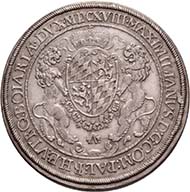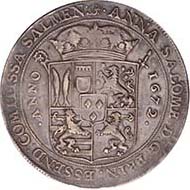Patrona Bavariae
Depictions of the Madonna from the Pielsticker Collection
CLUPEVS OMNIBVS IN TE SPERANTIBVS, a shield to all who hope in thee, this is how the legend of a magnificent Bavarian taler from 1738 reads.
BAVARIA. Charles VII Albert, 1726-1745. Taler 1738, Munich. Dav. 1942. Hahn 248. From the upcoming auction Künker 184 (2011), 4085. Estimate: 5,000 Euros.
The coin depicts Mary, patroness of Bavaria, holding the infant Christ which elevates the right hand in a gesture of blessing in her arms. Mary is omnipresent on Bavarian talers. The “Madonnentaler“ were produced in great numbers, and popular medicine often drew back on them. “A Marientaler, when hold in the hand, protects the mother-to-be from difficult delivery. Even more effective is the taking of chippings from that taler. Medically active, however, are only those pieces which depict the Mother of God carrying the child on the right-hand side.” This advice can be found in the concise dictionary of German superstition.
But how did Virgin Mary end up on Bavarian coins? And why, of all countries, is it Bavaria that she ought to protect?
Saint Michael in Munich was built as church of the Society of Jesus. Photo: Luidger / Wikipedia.
Under the sign of the Counterreformation
The demands of the big reformers shook the Catholic Church to the very foundations. Many of the things criticized by Martin Luther or John Calvin were only too true. Amongst those whose task was to lead the people to faith personal piety was only seldom shown. A morally regeneration, therefore, was called for, which could only originate from the top of society.
A useful tool in this regard was the order of the highly educated Jesuits who schooled the entire Catholic upper class in Europe in religious and secular matters from the second half of the 16th century on. In 1549, William IV, Duke of Bavaria, called the Jesuits to the city of Ingolstadt where the training centre for the South German Catholic trainees was soon established. To remind the ruling classes-to-be of the ideals of their juvenile years after leaving the school, the Jesuits founded the Marian Congregation. In accordance with tradition of medieval brotherhoods their members revered Mary as Mother of God in both joint and private prayers.
Maximilian I of Bavaria (1573-1651), painting of Joachim of Sandrart, Kunsthistorisches Museum Wien. Photo: Wikipedia.
A Bavarian disciple
Maximilian, Duke of Bavaria from 1597 until 1651, and his cousin, subsequent Emperor Ferdinand II, likewise went to the Jesuit College in Ingolstadt. Maximilian entered school when he was 14 years old – the school left a mark on him for the rest of his life. Maximilian I became an eager follower of the Counterreformation and a loyal supporter of his Imperial cousin without ever neglecting his own agenda. Sacred Bavaria was at the centre of his thinking.
Bavaria Sancta – that was the title of the first volume of a collected edition written by the Jesuits on the most important Saints of the Duchy Bavaria, suggested by Maximilian himself and published in 1615. It was a summary of the Duke’s efforts to re-install the old religion. He had established four Jesuit Colleges for the education of the refined society, five Capuchin monasteries – likewise founded by him – sent out their preachers to the towns, the villages and the markets. For the elite young ladies the Sisters of Loreto were called to Munich. In contrast to the Protestant population of Bavaria who had to decide whether to convert or to emigrate, the Catholic citizens received a comprehensive religious training which enabled them to argue when Protestant preachers questioned their faith.
Mary as Patroness of Bavaria
Since the 4th century, patron saints had taken the position of the Roman patron. Churches, estates, guilds and orders, even entire cities and countries, placed themselves under the patrocinium of a saint.
From the beginning of the 17th century onwards, Maximilian preached Mary as new patroness of Bavaria. The Residence’s new Court Chapel was dedicated to her. Her statue protected the Munich Residence since 1616. The Bavarian soldiers went to war with “Mary“ as slogan and their flags were decorated with a picture of the Virgin Mary. Even Maximilian’s eldest son and heir to the throne was placed under the protection of Mary and was given the then rather unusual name Ferdinand Maria.
BAVARIA. Maximilian I, 1598-1651. Reichstaler 1618, Munich. Dav. 6064. Hahn 62 a. From the upcoming auction Künker 184 (2011), 4062. Estimate: 1,000 Euros.
Mary on coins
Naturally Mary occupied the Bavarian coin design, too. As “Madonna of the Apocalypse”, Mary sits enthroned in the clouds, supports her feet on the moon crescent and wears a star gloriole. She holds a scepter in her right hand and carries the infant Christ on her left arm.
BAVARIA. Ferdinand Maria, 1651-1679. Reichstaler 1647, Munich in celebration of his vicariate. Dav. 6097. Hahn 180. From the upcoming auction Künker 184 (2011), 4081. Estimate: 2,500 Euros.
Mary was to become the commonest type on Bavarian coins. Other Catholic countries likewise adopted Mary, Mother of God, as coin type.
AUGSBURG. Johann Christoph von Freiberg, 1665-1690. Reichstaler 1681, Augsburg. Dav. 5009. Forster 397. From the upcoming auction Künker 184 (2011), 4016. Estimate: 5,000 Euros. – Johann Christoph von Freiberg, too, went to the Jesuit College in Ingolstadt.
BAMBERG. Marquard Sebastian Schenk von Stauffenberg, 1683-1693. Reichstaler 1691, Nuremberg. Dav. 5063. Krug 353. From the upcoming auction Künker 184 (2011), 4055. Estimate: 300 Euros. – Marquard Sebastian was one of the active patrons of the Jesuits.
ESSEN. Anna Salome von Salm-Reifferscheid, 1646-1689. Reichstaler 1672. Dav. 5277. Kramer 41. From the upcoming auction Künker 184 (2011), 4400. Estimate: 3,000 Euros. – Anna Salome likewise utilized the Jesuits to promote the Catholic Church amongst the Protestant population of Essen.
HATZFELD. Melchior, 1630-1658. Reichstaler n. d. (subsequently produced in 1666). Dav. 6709. From the upcoming auction Künker 184 (2011), 4491. Estimate: 1,500 Euros. – Melchior von Hatzfeldt-Gleichen attended the Jesuit College in Fulda where he was ordained a deacon.
All coins shown here are part of to the Pielsticker Collection which will be auctioned off on, March 16 and 17, 2011, in Osnabruck. The collection comprises 2,000 taler mainly from Germany, to a lesser degree also from Europe and overseas.
























